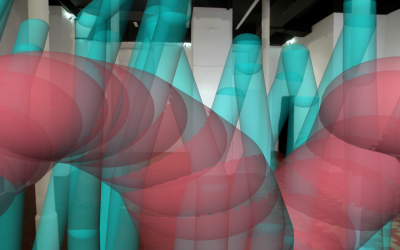Dominik Mahnič in Matic Potočnik
LUMEN
Drawing in augmented reality
You are kindly invited to the opening of the exhibition LUMEN: Drawing in augmented reality
by Dominik Mahnič and Matic Potočnik on Tuesday 17th January at 8 pm at Alkatraz Gallery. The exhibition will be on display until 3. February 2012.
Luminescence or luminosity (shortened luma) is an electromagnetic phenomenon that translates from reality by means of digital media to video projections and codes it into digital information that it then shows to the viewer in different frequencies. Our perception of light can be found within the physical borders of the frequency that the interactive installation for drawing in augmented reality extends into the third and fourth dimension, i.e. into space and time. LUMEN is a virtual interface that researches the field of augmented reality, wearable technologies and the visualisation of interactive environments. LUMEN is comprised of optical glasses with two cameras that enable the expansion of the virtual field and a stereo image shown on two screens for each eye individually. By looking the user merges the created images in the neuron image in the brain into one. The glasses include microchips that recognise the tilt of the head and other movements that the user might perform. They are connected to sensory devices that track spatial and time dimensions of movements, which are then translated into the virtual world so that they construct new surroundings with the use of algorithmic calculations. For tracking LUMEN uses a 'hacked' Kinect gaming sensory device, which the programmer and co-author Matic Potočnik connected to a programme that belongs into the field of physical computing. Kinect comprises of an interactive physical system, which connects and monitors physical movements with the use of computer software. The authors used open source technologies to construct the system, and the project code is also open for further use and adjustments according to the needs of the users. LUMEN is created in the operating system Lubuntu (Linux), in programming language C++, and libraries OpenNI and OpenCV for computer vision were used to connect it with Kinect.
LUMEN is an upgrade of the interactive installation Digital spray, which Dominik Mahnič developed as a prototype of a digital drawing system. The user of the digital spray held a special spray in his hands, which emitted infrared light once the cap was pressed, and this signalled the position of the spray onto the projection. The spray did not enable 'electronic pastorality’ of the paint or the translucence of the colour which is essential for a painting. It did also not sufficiently simulate the body movements while painting, for the drawing only appeared on the two dimensional screen. In his works Dominik Mahnič constantly deals with attempts to understand the artistic and painting formal expression (including luminosity) in the light of contemporary technologies. In one of his video experiments he positioned an analogue video mixer into a wheat field, so that he could create a contemporary interpretation of an impressionist painting (in a recording that lasted a few hours). In this experiment it is important to keep in mind that the characteristic sunlight in impressionist paintings was not a coincidence, but a consequence of the development of technology and the use of zinc in painting colours. Similarly the light installations by Dan Flavin were dictated by the popularisation of fluorescent neon lights or the development of the film and photography in the Light-Space Modulator of Laszlo Moholy-Nagy. The colours and the use of painting tools do thus not depend entirely on the painter's free will, but are conditioned by the development of technologies.
The cultural environment which determines the ideas linked to the construction of the hologram, virtual and drowning worlds is a realistic echo of the cyberpunk stories and science fiction films such as Strange days by Kathryn Bigelow, Until the end of the world by Wim Wenders, Johnny Mnemonic, Minority Report and Japanese animes. At first glance LUMEN is a typical example of virtual reality, but in reality it is its subgenre, which is called augmented reality, for the changes in the gravitational laws of the virtual space, which the painter constructs with the use of the interface, are dictated by the physical movements through space. The tool causes situations in the real space, which are a copy of the virtual world and not the other way round. This is not merely an application that would expand certain parts of reality, but a customised interface that is primarily presented within a gallery context and is to be used by painters. Its use surpasses the limitations of art, for it can potentially be used also for didactic or amateur purposes.
The tool takes into account the temporal characteristics of the painting that can be frozen and preserved as a digital image or left on the level of a digital signal, at which the older painting strokes slowly fade from the painting surface. It takes into account all three body movements that are characteristic for applying paint onto the painting surface: from the wrist, the elbow or from he shoulder and depends on the expressive tendencies of the painter. By including the body (painting) movement into the electronic medium, it emphasises the magical dimensions of the electronic age, which is coming increasingly closer to reality through its evolution. The 3D project is an upgrade for the painters of the new era, painters who click with the mouse. It is the next level in the investment of the cybernetic body which is attached to a wireless communication between one’s body and the visual field.
Text by Ida Hiršenfelder
artist
Dominik Mahnič www.youtube.com/user/sdgtr4
Matic Potočnik http://hairyfotr.psywerx.net/
Production
LJUDMILA - Ljubljana Digital Media Lab, www.ljudmila.org www.ljudmila.org
Koprodukcija
Computer Vision Laboratory, Faculty of Computer and Information Science, University of Ljubljana. www.fri.uni-lj.si/
KUD Mreža, Gallery Alkatraz
www.galerijalkatraz.org
Special thanks to
prof. dr. Franc Solina
Ljubljana, 2011 / 2012


